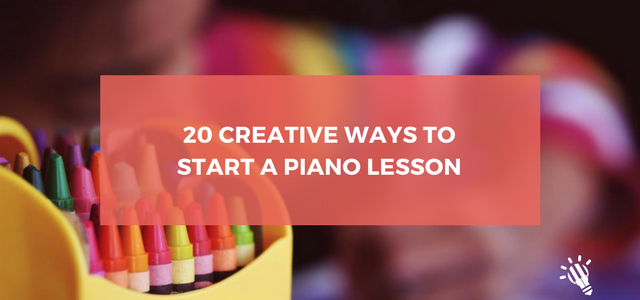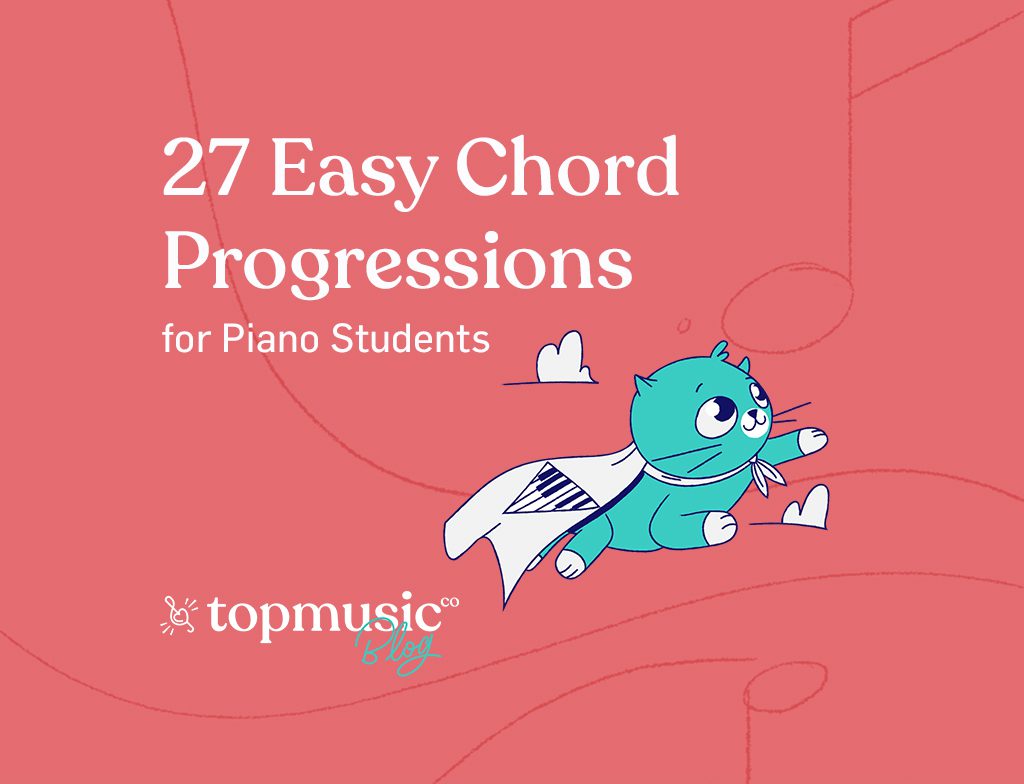Here are 27 easy chord progressions to inspire your students.
If you’re wanting to help unleash your students’ creativity and expand their understanding of chords, then playing through unseen piano chord progressions at the start of a lesson could be just what you need.
By experimenting with chords during piano lessons, rather than waiting for when a chord progression appears in a piece, you allow your students to:
Sounds good but you’re not sure which chord progressions to start with? Subscribe today and get instant access to Easy Chord Progressions to Inspire Creativity
Teaching basic piano chord progressions is sometimes only associated when students want to play pop music, and sees the student simply playing through the most common piano chord progressions: C major, G Major, F Major and A Minor.
While this illustrates how many songs (and even classical pieces like Pachelbel’s Canon) use the same simple chord progression, it can restrict the student’s creativity and understanding of how chords are used in many genres of music.
The “Easy Chord Progressions to Inspire Creativity” download is different.
It’s full of chord progressions that are NOT based on pop songs.
You’ll find popular chord progressions, but also emotional chord progressions that will see students experimenting with both major and minor keys. Overall, they are just chord progressions that sound really good and that I guarantee piano students will enjoy playing.
What activity do you tend to do at the start of your piano lessons?
Do you start with the question that every student dreads: “So, how much practice did you do this week!?”
Or ask them a more open question like, “What would you like to start with today?” or one of my favourites, “What did you have most fun with when you played piano this week?”
Or do you follow a regular routine starting with scales or sight reading first, followed by their pieces?
While all the above are perfectly legitimate piano lesson starters and there’s nothing wrong with any of them, I want to give you an alternate lesson starter that I think you and your students are going to LOVE.
One of my favourite starting activities for lessons with my piano students is to play through an unseen chord progression from my download: “Easy chord progressions to inspire creativity”
The reason I love starting piano lessons with creative activities like this is:
Want more creative ways to start your piano lessons? This is for you: 20 Creative Ways to Start Your Next Piano Lesson

To play all the chords in the “Easy Chord Progressions To Inspire Creativity” download, students will need to be able to form chord shapes on the white notes of the piano in root position to start.
If you’re new to teaching piano chords, then please check out some of my other resources including:
Above is an example of one of the four chord progressions from this sheet.
When I show a student the chord progressions sheet, I don’t demonstrate the chords for them. I most often ask them to choose one and get them to work it out first.
I want to see if they’ll be able to:
If any of those elements are missing, we can start working on it.
Note that the chord progressions are arranged in approximate order of difficulty, starting with a simple chord progression and moving through to harder.
Most are 4 chords long but they expand to longer progressions later in the download.
Here’s an example of a more complicated 4-chord progression:
Always encourage students to play the chord progressions with a sense of rhythm with the LH playing the bass note of the chord and the RH playing the chord in root position to start.
Show students how to use the pedal and for extra points, turn on a drum beat that they can play along to using an app or your digital piano – they’ll LOVE it. Start by changing chords every four beats, then encourage them to be more experimental.
You could even muck around with GarageBand.
And here’s what a longer chord progression looks like. This is an example in a jazzy style that introduces 7ths:
Another great thing about the piano chord progressions in this download is that they provide you with the opportunity to expand your students’ music theory by teaching new chord symbols and types of chords as they appear.
Sometimes it’s hard to know when to introduce inversions, 7th chords and slash chords. But when you use this lesson outline, when a slash chord appears at progression number 7, you can explain what that means.
When you first encounter 7ths, that’s a great opportunity to start exploring what 7ths are, how they sound and how they’re written as a chord symbol.
I tend to start with students playing the chord progressions with root position triads and, when ready, exploring how inversions can make the same chord progression sound better AND be easier to play.
You can also come back to a chord progression the student had previously explored and start adding inversions in the next lesson – it’s totally up to you.
For homework/practice, I get the student to write down a copy of the chord progression they were exploring into their assignment book/music diary, and I ask them to play through it some more at home (building on any great mistakes they make).
If they are confident, they can also record themselves playing through the chord progression on their phone or digital piano and then play it back and improvise over the top using a pentatonic scale.
Next lesson, make sure you have a listen back to what they’ve achieved before either building on it, or trying another chord progression.
Here are some ideas of how you can expand this approach:
Hopefully, these ideas will be enough to get you started with this fun chord progression activity. It can be used for groups, camps, workshops and 1-on-1 lessons and works with all ages and abilities (as long as they can form chord shapes).
To get your copy, scroll down and please enter your details below.
Subscribe today and get instant access to Easy Chord Progressions to Inspire Creativity.
Grab this free download of 27 engaging piano chord progressions you can use in your studio today.
Signing up sends you this free download, plus access to free teaching tips by email. Unsubscribe anytime.
I love having this chord progression handout ready on my piano at all times – it’s just such a fun, creative and inspiring way to start some of your lessons and I guarantee your students will enjoy it.
Just make sure you play through the chord progressions before sharing them with your students so that you feel comfortable when it comes to teaching them.
Have fun and let me know how it goes!

Joy says:
I need cords. That will
make decent tunes. I am able to understand flate and sharps. I would like to play two hands together